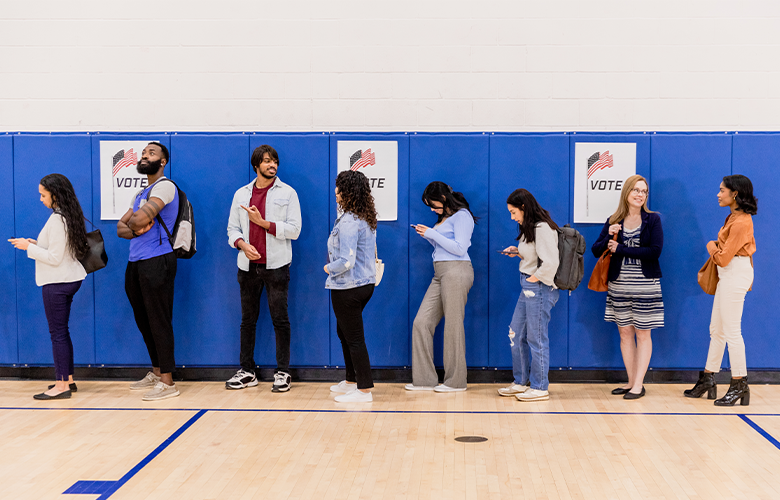
Did you have a say at school? Did any adults encourage you to get involved in something you care about? Did they urge you to vote?
What if more student voice meant more students voting?
New research from CIRCLE, the Center for Information & Research on Civic Learning and Engagement, connects student voice to voting and civic action: “The vast majority of students who felt they had strong student voice experiences in high school said they are extremely likely to vote in the 2024 election, and, moreover, they had a strong ‘civic engagement score,’” based on civic actions, such as volunteering or joining a protest.1
Opportunities for student voice have been shown to lead to greater student engagement,2, 3 but not even two in five young people (ages 18–34) surveyed by CIRCLE remembered feeling “their voice and opinion mattered” while in high school. And just over half of the students surveyed “recalled being explicitly encouraged to vote by a teacher in school.”4
If enabling students to pursue their interests and take responsibility for their learning is associated with increased civic engagement, why don’t we do it more?
Why don’t we all play this long game to get out the vote?
A number of EDC projects emphasize student-centered learning and student voice, including our free civics curriculum Supporting Readiness through Vital Civic Empowerment (SRVCE). Co-designed and refined with teachers who participated in our curriculum pilot, SRVCE is premised on the power of inquiry-based learning, in the form of student-led civics projects, to increase civic participation.
With SRVCE, students take the reins of their learning and explore issues they care about through a process of civic inquiry and action. Dr. Daton Dean, a SRVCE pilot teacher, affirmed, “One thing that I know about my students: They want to be heard. And they want to have a role in what they’re learning.”
“I used the scaffolding of the curriculum to encourage [my students],” noted Asim Gaffar, another SRVCE pilot teacher. “I recognized my school’s population and their fear of civic engagement, and I went step by step: learning your voice, learning your identity.”
Through the design, development, and testing of the SRVCE curriculum, we have distilled these strategies for promoting youth voice:
- Empower students to explore issues they care about. Structure coursework and provide supports so that students have the latitude to research topics of their choosing, then develop their own ideas and solutions.
- Value and encourage multiple perspectives. Building an inclusive classroom community is essential for students to feel comfortable discussing different points of view. Asma Ilyas, a student who has worked with the SRVCE curriculum, reflected, “There is a need for voices like mine in American discourse. We may not always agree, but we will be a stronger nation with more voices represented.”
- Develop media literacy skills for effective communication. Students need media literacy tools and acumen to analyze, evaluate, and make meaning of information from different sources. Moreover, media literacy skills help them create messages that communicate their views and resonate with their audience.
- Connect learning to career. Find ways to bridge the classroom and the real world that reflect students’ priorities for their future, such as career exploration and opportunities to collaborate with community and industry partners.
For impactful learning experiences that boost young people’s civic participation and likelihood of voting, educators and school leaders should make opportunities for students to develop their voices. It is about more than voting—it is about helping every student form their civic identity and take an active role within their school, community, and nation.
“I know so many people who don’t even realize that they can call their legislators,” said Leo Koulish, a SRVCE student advisor. “It’s very important to understand that you do have the right to speak up, you do have the right to have your voice heard.”
When students truly feel their voices matter, voting will follow.
Resources
View the SRVCE website for free adaptable lesson plans, slides, handouts, and a teacher toolkit for facilitating student-led civics projects, all designed to promote youth voice. The SRVCE program is funded by the U.S. Department of Defense.
| Wendy Rivenburgh is an expert in project-based learning, media literacy, and civics education. She provides training and resource development for a range of local, national, and international programs. | |
| Jessica Juliuson is an expert in whole school change. She leads innovative initiatives focused on instructional design, professional development, career and technical education, and youth empowerment.
|
1Center for Information & Research on Civic Learning and Engagement. (2024, March 12). Youth who develop their voice in high school are more likely to vote. https://circle.tufts.edu/latest-research/youth-who-develop-their-voice-high-school-are-more-likely-vote
2Mitra, D. (2018, August 20). Student voice in secondary schools: The possibility for deeper change. Journal of Educational Administration. https://www.emerald.com/insight/content/doi/10.1108/JEA-01-2018-0007/full/html
3Connor, J., Mitra, D. L., Holquist, S. E., & Boat, A. (2024, July 22). How teachers’ student voice practices affect student engagement and achievement: Exploring choice, receptivity, and responsiveness to student voice as moderators. Journal of Educational Change. https://doi.org/10.1007/s10833-024-09513-0
4Center for Information & Research on Civic Learning and Engagement, Youth who develop.


Add new comment